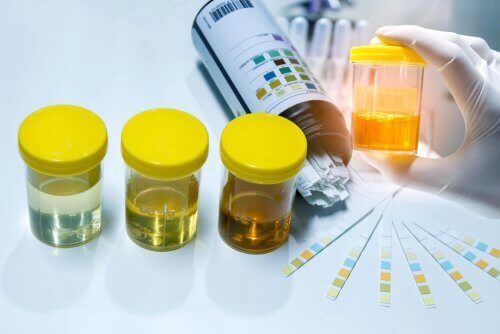The Presence of Nitrites in Urine


Written and verified by the doctor Leonardo Biolatto
Nitrites in urine are substances that help doctors diagnose a suspected urinary tract infection. Normally, there shouldn’t be any nitrites in the urine of humans. Thus, their presence is abnormal.
Urine is the liquid the kidneys produce to expel useless waste from the body. Through the outward expulsion of urine, it’s possible to filter the blood.
Nitrates are among the substances that are expelled through the urine. Although they sound like nitrites, the aren’t the same. Some are normal, while others aren’t. When the nitrates in urine encounter certain bacteria, they turn into nitrites. Therefore, the nitrite test is associated with urinary tract infections.
However, nitrites don’t only exist due to bacteria. Substances such as potassium nitrite or sodium nitrite are employed in the food industry. For example, they do this to artificially enhance the red color of meat.
Vegetables, on the other hand, usually contain nitrates. Green vegetables, beets, and radishes are rich sources of nitrates. That’s why the World Health Organization (WHO) establishes a daily limit intake of no more than 3.7 milligrams per kilogram of weight.
The nitrates the body can’t use and excretes through the urine can be taken by certain bacteria to become nitrites, as we stated above. However, not all bacteria have that ability. Nevertheless, the most common bacteria that cause urinary tract infections, such as the ones we’ll mention below, do have it. These include:
- Escherichia coli
- Enterobacteriaceae
- Proteus mirabilis
- Enterococci
When do doctors order the nitrite test?
Urinary tract infections have characteristic symptoms that make medical professionals suspect their presence. Thus, doctors orient their diagnosis towards cystitis when the patient tells them of certain classic symptoms. The symptoms include:
- Dysuria, or difficulty urinating
- Painful or burning urination
- Abnormally colored urine
- Polyuria, or the urgent need to urinate all the time
- Fever
Faced with this clinical picture, the medical professional may request a urinary nitrite test. However, he or she will probably request a complete urine analysis, not only a nitrite test. Also, they may combine a urinary nitrite test with a leukocyte esterase urine test. Testing positive in both is highly suggestive of a urinary tract infection.
Leukocyte esterase is an enzyme produced by neutrophils, basophils, eosinophils, and monocytes. These are white blood cells. Thus, testing positive indirectly indicates that there are white blood cells due to an infection.

Keep reading: The Best Remedies to Treat Urinary Tract Infections
How professionals perform the urinary nitrite test
Once the medical professional requests a complete urinalysis, including nitrites, the patient has to collect a urine sample in a sterile container. The container must be sterile to ensure that the biochemist accesses reliable results.
The patient must discard the first urine stream in the toilet and then proceed to collect the second part. If the patient takes the sample after several hours without urinating, it’ll be more reliable. For example, it’s best in the morning when they just woke up.
Then, a biochemist introduces a test strip in the urine to analyze it. The test strips contain substances that change color when they detect what they want to measure. Generally, test strips don’t measure a single element, but instead contain various reagents to make the process more effective. A single test strip can detect nitrites, glucose, esterase, and proteins.
Although it depends on the brand, urine nitrite reagents usually turn pink when they’re detected. However, each test strip manufacturer specifies the colors and their interpretation on the labels.

Find out more here: Natural Remedies to Relieve Interstitial Cystitis
How doctors interpret the results
So what happens if the patient tests positive for nitrites in urine?
Let’s say that a patient decides to visit their doctor due to a burning sensation during urination and fever. Thus, the medical professional requests a urinalysis and the laboratory reports that the patient tested positive for nitrites. The positive result suggests a urinary tract infection. If we add that the patient tests positive for leukocyte esterase, then there’s a diagnosis.
Then, the medical professional may indicate an antibiotic treatment without waiting for the urine culture. However, they may modify the antibiotic later after the culture results come back. Finally, a urine culture can confirm the urinary tract infection diagnosis and specify the type of antibiotic the medical professional should prescribe.
All cited sources were thoroughly reviewed by our team to ensure their quality, reliability, currency, and validity. The bibliography of this article was considered reliable and of academic or scientific accuracy.
- Cochat, P., & Freychet, C. (2016). Análisis de orina con tira reactiva: interés en nefrología pediátrica. EMC-Tratado de Medicina, 20(3), 1-5. https://www.sciencedirect.com/science/article/abs/pii/S1636541016794839
- Desvignes, V. (2023). Análisis de orina con tira reactiva: interés e interpretación en nefrología pediátrica. EMC-Tratado de Medicina. https://www.sciencedirect.com/science/article/pii/S1636541023476933
- Moreno, B., Soto, K., & González, D. (2015). El consumo de nitrato y su potencial efecto benéfico sobre la salud cardiovascular. Revista chilena de nutrición, 42(2), 199-205. https://www.scielo.cl/scielo.php?pid=s0717-75182015000200013&script=sci_arttext
- Rangaiahagari, A., Nyirabanzi, J., Uwizeyimana, J. P., Ngoga, E., & Wane, J. (2015). Comparison of urine culture and urine dipstick nitrite test in diagnosis of Urinary Tract Infection. Rwanda Medical Journal, 72(1), 5-7. https://www.bioline.org.br/abstract?rw15001
- Tiso, M., & Schechter, A. N. (2015). Nitrate reduction to nitrite, nitric oxide and ammonia by gut bacteria under physiological conditions. PloS one, 10(3), e0119712. https://journals.plos.org/plosone/article?id=10.1371/journal.pone.0119712
- Villamil Galindo, J. E., & Piagentini, A. (2021). El uso de Nitratos y Nitritos en la Industria cárnica, lo bueno, lo malo y el modelado matemático para optimizar su uso: Una revisión. https://ri.conicet.gov.ar/handle/11336/167327
This text is provided for informational purposes only and does not replace consultation with a professional. If in doubt, consult your specialist.








